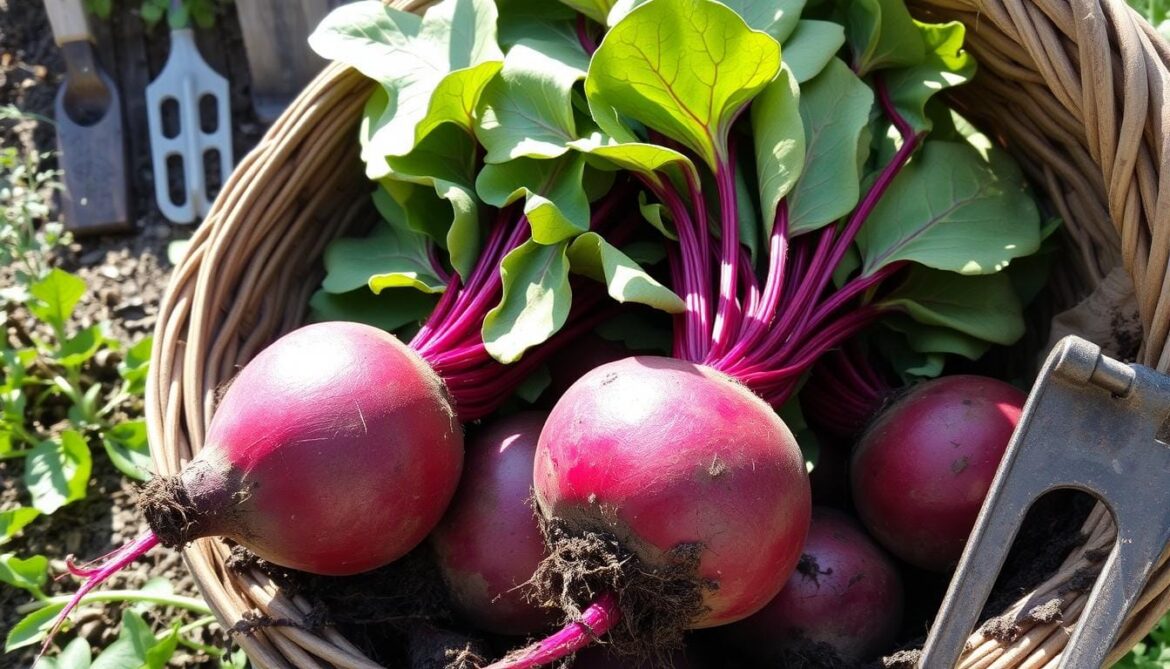The first time I pulled out a beet from the garden, I felt a deep connection. Harvesting red beets is more than just picking vegetables. It’s about understanding the soil, seed, and seasons’ dance.
Beet cultivation is an art that needs patience and attention. We start our journey by learning about their growth cycle. Most beets take 50 to 60 days to grow fully. You can harvest them about 7 to 8 weeks after planting.
Knowing when to harvest beets is key to a great crop. Beets should be about the size of a golf ball when you pick them. This size ensures they are tender and sweet, perfect for cooking.
Key Takeaways
- Beets can be harvested 7-8 weeks after planting
- Optimal harvest size is approximately 1 inch in diameter
- Different sizes suit different cooking methods
- Cooler weather produces the best beet quality
- Harvest timing impacts flavor and texture
Understanding the Growth Cycle of Red Beets
Root vegetable farming is all about knowing how crops grow. Beets are special because they give us two tasty parts: the roots and the greens. Let’s dive into their amazing growth journey and see how they develop.
Seed Germination and Early Growth
Beet seeds are amazing because they can sprout in the right conditions. They usually start growing in 5 to 8 days when the soil is at least 50°F. Interestingly, beet seeds often contain multiple seeds per capsule, which can result in multiple sprouts from a single planting.
- Optimal seed planting depth: 0.5 inches
- Seed spacing: 1 to 2 inches apart
- Row spacing: 1 to 1.5 feet
- Germination temperature range: 45°F to 85°F
Development Stages of Beets
Beets go through different growth phases during farming. They start as seedlings and grow their first true leaves. They need steady water and at least 6 hours of sunlight a day to grow well.
“Successful beet farming is about understanding each stage of plant development and providing optimal growing conditions.”
Overall Beet Lifespan
Beets usually take 50 to 70 days to grow after planting. Farmers can plant beets every 2 to 3 weeks until mid-summer. This way, they get a steady supply of fresh beets all season long.
| Growth Stage | Key Characteristics |
|---|---|
| Germination | 5-8 days, soil temperature 50°F |
| Seedling | Develop first true leaves |
| Mature Growth | 50-70 days, root diameter 1-3 inches |
Signs That Our Beets Are Ready for Harvest
Figuring out when to harvest beets is key. We need to watch for certain signs to get the best flavor and nutrition. Knowing when to pick them is important.
Size and Color Indicators
Beet maturity shows in clear ways. We look for specific signs to know when to harvest:
- Shoulders peeking 1-2 inches above soil surface
- Root diameter between 1-3 inches
- Rich, deep color development
- Uniform root shape
Foliage Changes
The leaves of the beet plant tell us a lot. Healthy foliage means a good beetroot harvest. We check for:
- Tall, vibrant green leaves
- Leaf density suggesting strong energy collection
- No more than one-third of leaves removed
Soil Condition
Soil is very important for beets. Our success in harvesting depends on it:
| Soil Indicator | Harvest Readiness |
|---|---|
| Loose, well-drained soil | Optimal root development |
| Moderate moisture | Supports root swelling |
| No compaction | Easier root extraction |
“The secret to a perfect beetroot harvest lies in understanding the subtle signs of plant maturity.” – Garden Wisdom
We harvest beets by watching their size, color, leaves, and soil. By paying attention to these, we get the best beets. They taste great and are full of nutrients.
Ideal Timeframe for Harvesting Red Beets
Beet farm management needs careful timing and knowing when to harvest. Our guide shows gardeners and farmers when to pick red beets for the best taste and health benefits.
Knowing when to harvest is key in beet farming. Beets are ready between 50 to 70 days after they’re planted. This time can change based on the weather and soil.
Seasonal Planting Considerations
When to plant beets is very important. We suggest planting in the cool seasons:
- Early spring for the first crop
- Late summer/early fall for a second crop
- Don’t plant in very hot weather
Early vs Late Harvesting Differences
Harvesting at different times brings out different qualities:
| Harvest Stage | Size | Flavor Profile | Best Use |
|---|---|---|---|
| Baby Beets | 1-2 inches | Mild, Sweet | Salads, Garnishes |
| Mature Beets | 2-3 inches | Robust, Earthy | Roasting, Cooking |
Climate Impacts on Beet Growth
The weather greatly affects beet growth. Light frost can make beets sweeter, making fall harvests extra special. In places without cold, beets can be grown in winter with the right care.
“The secret to perfect beets lies in understanding their growth rhythm and respecting their seasonal preferences.” – Experienced Beet Farmer
Our beet farm strategy is all about being flexible. By watching the soil and plants, we can pick the best time for a delicious beet harvest.
How to Check Beet Maturity
Figuring out when to harvest beets needs careful watching and hands-on methods. Learning how to harvest beets right can boost our crop’s yield. It ensures we pick them at the best time.
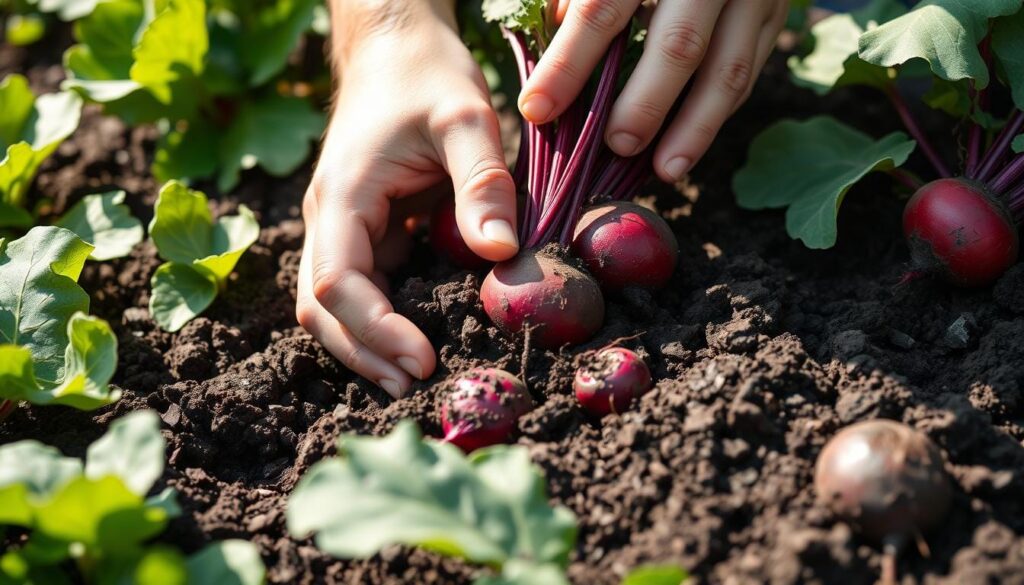
Knowing when beets are ready involves several important steps. Gardeners can use these methods to check if their beets are ready to be picked. We’ll look at some effective ways to pick beets at the perfect moment.
Using a Soil Knife
A soil knife is key for checking beet maturity. We can dig around the beet’s base to see its size and growth. Professional gardeners suggest this method to avoid damaging the roots during inspection.
- Carefully insert the soil knife at a 45-degree angle
- Gently lift the soil around the beet
- Examine the root’s size and color
The Tug Test
Knowing when to harvest is key for a good beet crop yield. The tug test is a simple way to check if beets are ready. If a beet resists a bit but comes out easily, it’s likely ready.
| Beet Size | Harvest Readiness | Recommended Action |
|---|---|---|
| Golf ball size (1 inch diameter) | Ready for harvest | Proceed with harvesting |
| Smaller than golf ball | Not mature | Leave in ground |
| Tennis ball size | Fully mature | Harvest immediately |
Color Changes
Visual signs are important for checking beet maturity. Look for deep, rich colors in the leaves and root. A vibrant green top and a deep burgundy or crimson root mean beets are ready to be picked.
Remember, beets typically reach maturity 50 to 70 days after planting. Patience and careful observation are key to successful harvesting!
Recommended Harvesting Techniques
Learning how to harvest beets is key to keeping our garden’s produce fresh. To get the best from our beets, we need to plan carefully and use the right methods.
Best Tools for Harvesting Beets
Choosing the right tools is important for harvesting beets. Here are our top picks:
- Garden fork or spade for gentle soil loosening
- Hand trowel for smaller garden plots
- Pruning shears for trimming beet tops
- Soft-bristled brush for cleaning
Minimizing Harvest Damage
It’s vital to protect our beets during harvest to keep them in top shape. Beet harvesting techniques that help avoid damage include:
- Work at least six inches from the beet crown
- Gently loosen soil around the roots
- Avoid puncturing or bruising the vegetables
- Lift beets carefully to prevent breaking
Timing and Weather Considerations
Our beet field operations rely on timing and weather. Most beets are ready to pick between 45 to 90 days after planting. We suggest picking them when they’re the size of a golf ball to a tennis ball for the best taste and storage.
“The key to perfect beet harvesting is patience and careful observation.” – Garden Wisdom
For the best harvest, look for these conditions:
- Dry soil for easier extraction
- Mild temperatures
- Avoid extreme heat or cold
- Harvest before the first hard frost
Post-Harvest Handling for Red Beets
After we harvest beets, it’s important to handle them right. This keeps their quality and taste good for longer. Good beet farm management means paying close attention to how we care for them after we pick them.
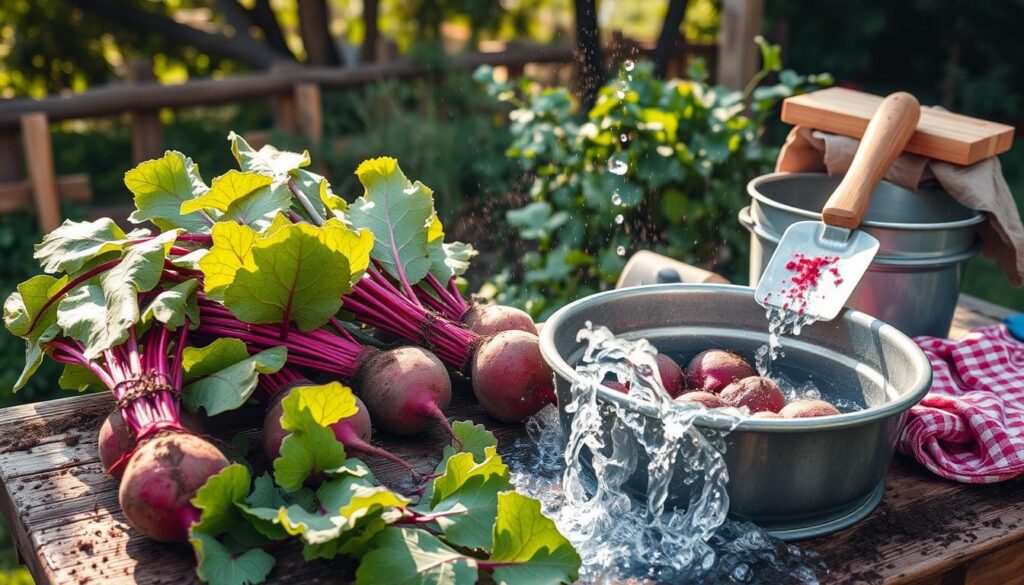
Cleaning Beets After Harvest
Cleaning is key in beetroot harvest. Here’s what we do:
- Gently remove excess soil without washing immediately
- Trim stems to 2 inches above the beet
- Remove any damaged or diseased roots
- Use a soft brush to clean delicate surfaces
Proper Storage Methods
Knowing how to store beets is part of good beet farm management. Our storage methods help keep them fresh and last longer.
| Storage Method | Duration | Conditions |
|---|---|---|
| Refrigerator | 2-4 weeks | Produce drawer, unwashed |
| Root Cellar | 2-3 months | Cool, humid environment |
| Canning | 12-18 months | Sealed jars, processed correctly |
Maintaining Freshness
To keep beets fresh, we follow these tips:
- Keep beets cool and slightly humid
- Do not wash before storing
- Remove greens to prevent moisture loss
- Check stored beets weekly for signs of spoilage
*”Proper post-harvest handling transforms good beets into exceptional produce.”*
Our careful steps make sure every beet stays nutritious, colorful, and tasty. This way, they go from our farm to your table perfectly.
Benefits of Harvesting Beets at Peak Ripeness
Getting the timing right for harvesting beets can make a big difference. Knowing when beets are at their best can bring out their full flavor and nutritional value. This also helps in keeping them fresh for longer.
Enhanced Flavor Profiles
Beets picked at the right time taste amazing. Optimal ripeness means they are sweeter and softer. We should aim to harvest them when they are 2-3 inches in diameter.
- Sweeter taste when harvested at ideal maturity
- More tender texture
- Rich, earthy flavor development
Nutritional Powerhouse
Beets at their peak are packed with nutrients. Proper harvesting techniques help keep these nutrients at their highest levels. This includes potassium, folate, and manganese.
| Nutrient | Amount per 100g |
|---|---|
| Potassium | 325 mg |
| Folate | 109 μg |
| Manganese | 0.33 mg |
Extended Shelf Life
Harvesting at the right time can also make beets last longer. They can stay fresh for up to six months. This is if they are picked when ripe and stored in cool, humid conditions.
Harvesting beets is an art that balances timing, technique, and understanding of plant biology.
By learning how to harvest beets correctly, we turn a simple garden task into a precise and rewarding activity. It enhances the taste, nutrition, and shelf life of our beets.
Common Mistakes to Avoid
Growing beets can be tough, even for beginners. Our beet farming tips show you what mistakes to steer clear of. Knowing these errors can help you grow better beets.
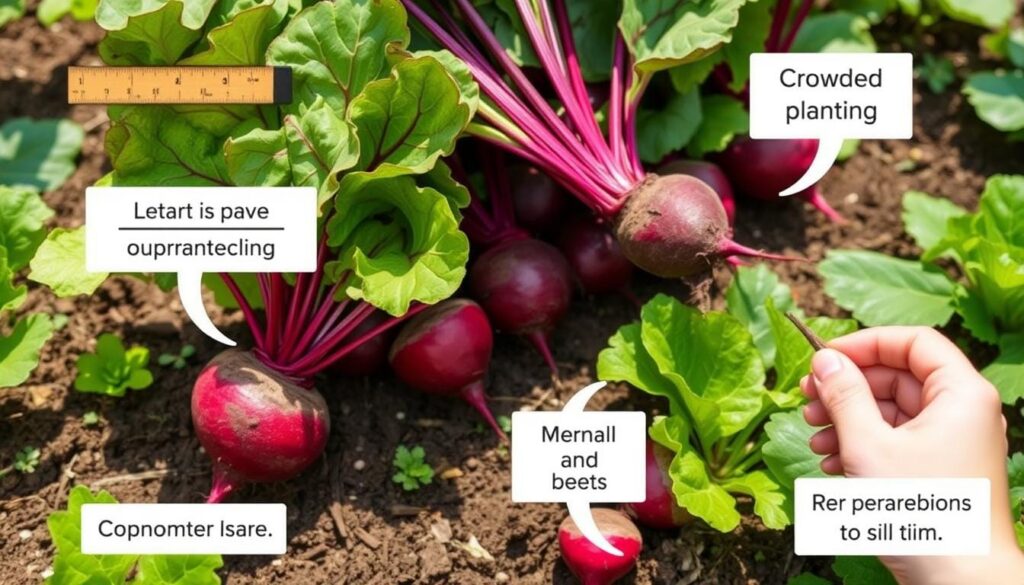
Overcrowding in the Garden
Beets need enough space to grow well. Too much crowding can slow growth and cut down on yield. Here’s how to space them right:
- Plant beet seeds 3-4 inches apart
- Thin seedlings to let roots grow
- Be careful with multigerm seeds, as they have many seeds per cluster
Ignoring Soil Quality
Good soil is key for growing beets. Our tips stress the need for:
- Soil pH between 6.0 and 7.5
- Soil temperature between 50-65°F
- Adding compost to improve soil
Harvesting Timing Challenges
Harvesting at the right time is vital. Beets picked too soon or late lose flavor and nutrients. Look for these signs:
- Check if the roots are 2-3 inches big
- Watch the health of the leaves
- Think about the season you’re growing in
“Successful beet farming is about precision and patience.” – Experienced Gardener
Avoiding these mistakes can lead to a great beet harvest. This way, your garden can reach its full promise.
How to Store Beets for Maximum Longevity
Keeping our beets fresh is key. Beet farm management teaches us how to store them well. This guide will show you how to keep your beets fresh and tasty.
Storing beets right is important. When stored well, fresh beets stay crisp and flavorful. This helps you get the most from your harvest.
Ideal Storage Conditions
Here are some storage tips:
- Keep them in a cool place, between 32°F to 40°F
- Leave 1 inch of stem when cutting greens
- Store in a sealable plastic bag to remove excess air
- Keep beets away from ethylene-producing fruits
Refrigeration Tips
Refrigeration is great for keeping beets fresh. When stored right, fresh beets can last up to 14 days in the fridge. Put them in the crisper drawer to keep them cool and a bit humid.
Freezing Techniques
Freezing is a good way to keep beets for a long time. Cooked beets can be frozen for up to 8 months. This makes it easy to save our crop. Here’s how to freeze:
- Cook beets until they’re tender (30-40 minutes)
- Cool them down completely
- Cut them into the sizes you want
- Pack them in freezer-safe containers
“Proper storage is the key to enjoying your beet harvest months after picking.” – Farming Wisdom
Using these storage tips, we can keep our beets fresh and healthy. This way, we can enjoy them long after we pick them.
Cooking with Freshly Harvested Red Beets
Months of hard work in beet cultivation and farming pay off when we cook with them. Our fresh beets open up a world of tasty dishes beyond just sides.
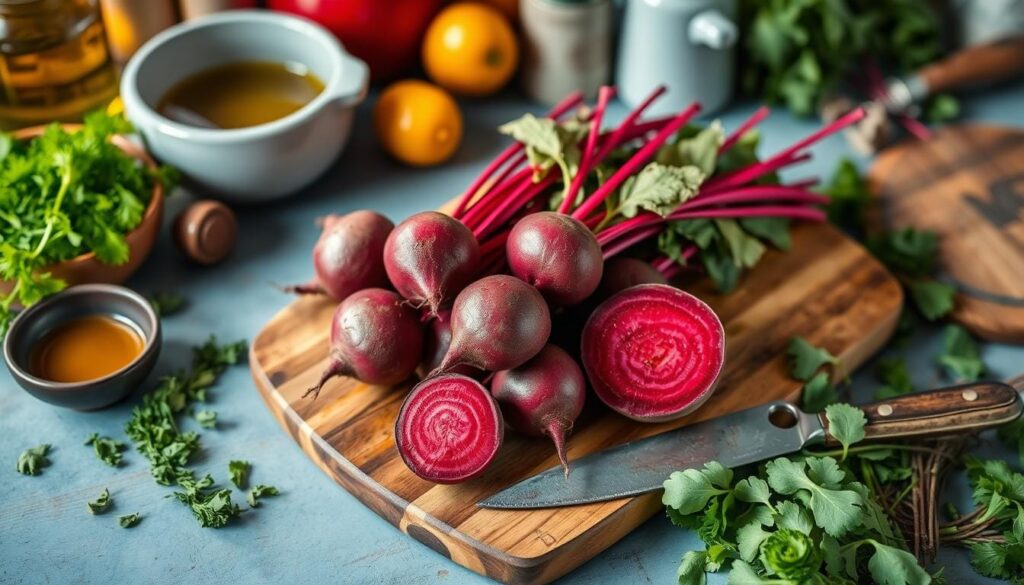
Beets are a kitchen superstar, full of nutrients and flavor. A 3.5-ounce serving has only 44 calories. It’s also a good source of folate and manganese.
Popular Recipes to Try
- Roasted Beet Salad with Goat Cheese
- Beet Smoothies
- Pickled Beet Appetizers
- Beet Hummus
- Baked Beet Chips
Nutritional Benefits of Cooking Beets
Choosing the right cooking method keeps beets nutritious. Steaming saves more water-soluble nutrients than boiling. Each method has its own benefits:
- Boiling takes 30-60 minutes
- Steaming requires 30-45 minutes
- Roasting at 425°F needs 45-60 minutes
- Grilling takes approximately 16-20 minutes
Creative Ways to Incorporate Beets
Our beet cultivation leads to creative recipes. Raw beets are great for juicing, salads, or as vibrant sides. They’re packed with 13 grams of carbs and 4 grams of fiber per cup.
“Beets are not just a vegetable, they’re a culinary canvas waiting to be explored!” – Chef Maria Rodriguez
Beet tip: Keep 2 inches of stalk on for less bleeding during cooking. This trick boosts flavor and cuts down on kitchen mess.
Companion Planting for Healthy Beets
Beet cultivation needs careful planning. Companion planting is a smart way to grow healthier beets. It improves soil, keeps pests away, and boosts beet production.
Beneficial Plant Pairings
Choosing the right neighbors for your beets can make a big difference. Here are some top picks:
- Cabbage family crops (kale, cauliflower, broccoli)
- Onions and garlic to keep pests away
- Lettuce to keep soil moist and shaded
- Marigolds to attract good bugs
- Carrots to improve soil structure
- Peas and beans to fix nitrogen
Plants to Avoid Near Beets
Some plants can harm your beets. Keep them far away:
- Nightshade family (tomatoes, potatoes, peppers)
- Other goosefoot family plants (spinach, chard)
- Pole beans that steal nutrients
- Mustard greens that attract pests
Rotation Strategies
Good crop rotation keeps soil healthy. Here’s how to do it:
- Give goosefoot family plants a 4-year break
- Alternate heavy feeders like cauliflower with beets
- Plant nitrogen-fixing legumes before or after beets
“Companion planting is not just about placing plants together, but creating a harmonious ecosystem that supports each crop’s growth.” – Garden Wisdom
Learning about companion planting helps create a garden that thrives. It boosts beet production and keeps all plants healthy.
Natural Pest Control for Beet Gardens
Keeping our beet crops safe from pests is key to a successful beet farm. We need a plan that includes prevention, watching for pests, and acting when needed.
Integrated Pest Management (IPM) is a smart way to handle pests. It helps us know which pests are common and how to stop them. This way, we can keep our beets healthy and our gardens thriving.
Common Pests Affecting Beets
- Aphids: Can stunt growth and distort leaves
- Spider mites: Potentially cause significant leaf drop
- Whiteflies: May lead to leaf yellowing and wilting
- Flea beetles: Create holes in beet foliage
- Mealybugs: Weaken plants and cause leaf damage
Preventive Measures
We should make our gardens less welcoming to pests:
- Keep the garden clean by removing trash
- Plant things that help each other
- Change where we plant things from year to year
- Check plants often for pests
Organic Treatment Options
| Pest | Organic Treatment |
|---|---|
| Aphids | Neem oil spray |
| Flea beetles | Diatomaceous earth |
| Spider mites | Insecticidal soap |
Being proactive in pest control is essential for protecting our beets and getting a good harvest.
Prevention is always better than cure in beet field operations.
Planning Our Next Beet Planting Cycle
As we finish our current beet harvest, it’s time to plan for the next one. Successful beet growing needs careful planning and smart farming practices. These ensure a big crop every year.
Understanding Seasonal Planting Strategies
Timing is key in our beet farming. Beets do best when planted at certain times. Our main planting times are:
- Early spring: 4 weeks before the last frost
- Mid-summer: Keep planting until mid-August
- Fall: Plant up to six weeks before the first frost
Secrets to Successful Beet Seeds
Knowing about beet seeds is vital for them to grow well. Each seed has many embryos, so we must thin them out. Here are our best tips:
- Plant seeds half an inch deep
- Keep plants 2-3 inches apart
- Water the soil 1-2 times a day
- Soil should be 45-50°F for planting
Crop Rotation: A Sustainable Approach
We use crop rotation in our beet farming. Rotating crops every 3-5 years stops diseases and keeps soil healthy. This makes our garden more productive and beets grow better in the future.
“Crop rotation is not just a technique, it’s a commitment to sustainable gardening.” – Experienced Gardener
By using these strategies, we’re ready for a great beet growing season. We aim to get the most from our harvest while keeping our garden healthy.
Conclusion: Enjoying Our Beet Bounty
Our beet crop is the result of hard work and careful planning. From planting tiny seeds to harvesting beetroot, we’ve shown dedication. Each beetroot is a symbol of patience and understanding nature’s ways.
Our gardening is all about sustainability. We focus on the details like soil pH and spacing. This way, we get about 5 to 10 pounds of beets from just 10 feet of row.
Harvesting beets is more than just a job. It’s a chance to share fresh food with loved ones. We can cook, preserve, or give away these healthy veggies, spreading the joy of homegrown food.
Reaping the Rewards of Our Efforts
Our beetroot harvest is more than just food. It shows our dedication to sustainable gardening. Every beet is a result of our hard work, from choosing the right varieties to keeping our garden healthy.
Encouraging Sustainable Practices
Our organic gardening helps our ecosystem. Our small garden shows that even home gardeners can make a big difference. It’s a lesson in responsible farming.
Sharing Our Harvest with Others
Gardening connects us to the earth and our community. Sharing our beetroot harvest is more than giving food. It’s about sharing knowledge, joy, and appreciation for our food.
